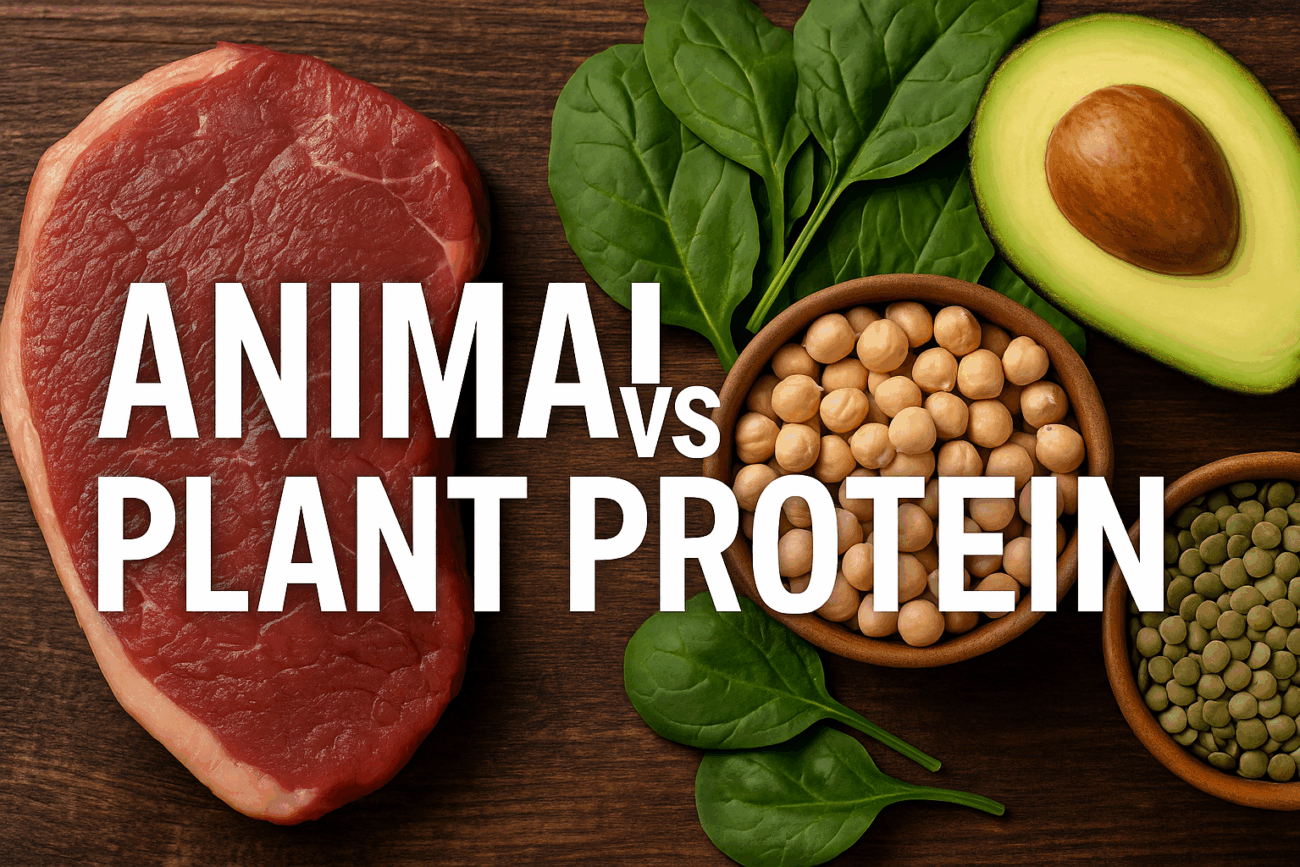🧠 Introduction: Animal vs Plant Protein — Which One Wins?
Eggs or tofu? Chicken or chickpeas? Choosing the right protein can feel overwhelming—especially when social media, health gurus, and headlines all say different things.
If you’ve ever wondered which protein is truly better for your body, goals, and the planet, you’re in the right place.
This guide will break down everything you need to know about animal vs plant protein, including:
- The truth about protein for muscle growth
- Key plant protein benefits for heart and health
- How to build protein-packed meals easily
- The case for a smart, flexitarian protein plan
Let’s simplify the science and help you build a better plate—fast.
🥩 What Is a Complete Protein? And Why It Matters
Your body needs 20 amino acids. It makes 11. The other 9 must come from food.
- Animal proteins (like meat, eggs, and dairy) contain all 9 essential amino acids—they’re known as complete proteins.
- Most plant proteins (like beans and grains) miss one or two. But when you combine them (like rice and lentils), they cover the full spectrum.
✅ Key Tip: Quinoa, soy, hemp, and chia seeds are complete protein plant sources.
💪 Protein for Muscle: Why Animal Protein Builds Faster
Looking to build muscle?
- Animal proteins have more leucine, which boosts muscle repair.
- They’re easier for your body to absorb and use.
📊 A Journal of Nutrition study showed that participants using animal protein gained muscle more quickly. However, those using blended plant proteins with varied amino acids still made strong progress.
✅ Combine lentils, quinoa, and seeds to match the benefits of meat-based proteins.
❤️ Plant Protein Benefits: Better for Heart Health & More
Research from Harvard University found that replacing even 3% of animal protein with plant protein lowered the risk of heart disease by up to 19%.
Why? Plant protein heart health perks include:
- Low saturated fat and cholesterol
- High in fiber (animal protein has none)
- Contains antioxidants that support cell health
✅ Regularly eating tofu, tempeh, lentils, and chickpeas supports your heart and long-term health.
⚖️ Complete Comparison: Animal vs Plant Protein Pros & Cons
| Protein Type | Pros | Cons |
|---|---|---|
| Animal | Builds muscle fastComplete proteinHigh in iron and B12 | High saturated fatNot eco-friendlyMay increase inflammation |
| Plant | Heart-healthyRich in fiberEco-conscious | Some are incompleteLower in B12May need combining |
✅ Balanced meals using both sources give you the best of both worlds.
🌱 Sustainable Protein Choices for You & the Planet
Choosing more plant protein is also better for the Earth.
- Requires less land and water
- Produces fewer greenhouse gases
- Supports long-term global food stability
So, adding more lentils and soy isn’t just good for you—it’s good for the world.
✅ Even one plant-based day per week makes a difference.
🥗 Flexitarian Protein Plan: Why Mixing Is Best
You don’t have to go full vegan or carnivore.
A flexitarian protein plan gives you:
- The muscle-building power of animal protein
- The long-term health benefits of plant protein
- A variety of flavors and nutrients
Try this simple strategy:
- 💪 Muscle goals → Add lean meat + varied plant proteins
- ⚖️ Weight loss protein plant vs animal → Favor plant-based with occasional lean animal options
- ❤️ Heart health → Focus mostly on plants, with minimal meat
✅ Always choose whole foods over ultra-processed protein products.
🍽️ Easy Protein-Packed Meals for Everyday Energy
Build your week around these protein-packed meals:
Breakfast
- Greek yogurt with flax + berries (animal)
- Oatmeal with almond butter + chia seeds (plant)
Lunch
- Chicken quinoa bowl with roasted veggies (combo)
- Black bean burrito with avocado and rice (plant)
Dinner
- Grilled salmon + steamed broccoli + brown rice (animal)
- Tofu stir-fry with soba noodles and veggies (plant)
Snacks
- Cottage cheese + apple slices (animal)
- Roasted edamame or pea protein shake (plant)
✅ Use these meals to rotate your protein sources naturally.
🧠 Final Word from the Experts
Nutritionists agree on one thing: balance works best.
- Animal protein fuels strength and recovery.
- Plant protein protects your heart, gut, and waistline.
Don’t fall into extremes. Create a meal plan that includes the best of both, and you’ll feel stronger, more energized, and healthier over time.
✅ Conclusion: Your Smarter Protein Strategy Starts Now
Let’s recap:
- Animal vs plant protein doesn’t have to be a battle
- Combine the two for better strength, health, and sustainability
- Choose real, whole protein foods whenever possible
Take action today:
- Add one plant-based protein meal to your weekly plan
- Try a new combo meal using both protein types
Small changes build strong habits—and stronger bodies.
You May Also Like:
- Avocado Toast with Cottage Cheese – High-Protein Recipe
- Eat More to Lose Weight: What to Eat Right Now
- 30 Mindfulness Activities to Find Calm at Any Age
- Protein Shakes : 8 New Points To Lose Weight and Belly Fat
NCBI – What is Protein
Harvard Chan – Plant protein heart benefits
MDPI – Animal- and Plant-Based Protein Sources
Eatingwell – Plant based protein benefits
NCBI studies on plant protein, obesity, glycemic control
https://www.doctorkiltz.com/kiltz-blog/animal-protein-vs-plant-protein/

